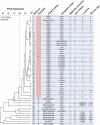Methicillin-resistant Staphylococcus capitis with reduced vancomycin susceptibility causes late-onset sepsis in intensive care neonates
- PMID: 22348102
- PMCID: PMC3279402
- DOI: 10.1371/journal.pone.0031548
Methicillin-resistant Staphylococcus capitis with reduced vancomycin susceptibility causes late-onset sepsis in intensive care neonates
Abstract
Background: Coagulase-negative staphylococci, mainly Staphylococcus epidermidis, are the most frequent cause of late-onset sepsis (LOS) in the neonatal intensive care unit (NICU) setting. However, recent reports indicate that methicillin-resistant, vancomycin-heteroresistant Staphylococcus capitis could emerge as a significant pathogen in the NICU. We investigated the prevalence, clonality and vancomycin susceptibility of S. capitis isolated from the blood of NICU infants and compared these data to adult patients.
Methodology/principal findings: We conducted a retrospective laboratory-based survey of positive blood cultures in NICU infants ≥ 3 days of age (n = 527) and in adult ICU patients ≥ 18 years of age (n = 1473) who were hospitalized from 2004 to 2009 in two hospital centers in Lyon, France. S. capitis was the most frequent pathogen in NICU infants, ahead of S. epidermidis (39.1% vs. 23.5% of positive blood cultures, respectively). Conversely, S. capitis was rarely found in adult ICU patients (1.0%) compared to S. epidermidis (15.3%). S. capitis bloodstream isolates were more frequently resistant to methicillin when collected from NICU infants than from adult patients (95.6% vs. 53.3%, respectively). Furthermore, we collected and characterized 53 S. capitis bloodstream isolates from NICU infants and adult patients from six distant cities. All methicillin-resistant S. capitis isolates from NICU infants were clonally related as determined by pulsed-field gel electrophoresis. These isolates harbored a type V-related staphylococcal chromosomal cassette mec element, and constantly showed either vancomycin resistance (37.5%) or heteroresistance (62.5%). Conversely, the isolates that were collected outside of the NICU were genetically diverse and displayed much lower rates of vancomycin resistance and heteroresistance (7.7% and 23.1%, respectively).
Conclusions/significance: A clonal population of methicillin-resistant S. capitis strains has spread into several French NICUs. These isolates exhibit reduced susceptibility to vancomycin, which is the most widely used antimicrobial agent in the NICU setting.
Conflict of interest statement
Figures



Similar articles
-
Methicillin-resistant Staphylococcus epidermidis isolates with reduced vancomycin susceptibility from bloodstream infections in a neonatal intensive care unit.J Med Microbiol. 2020 Jan;69(1):41-45. doi: 10.1099/jmm.0.001117. J Med Microbiol. 2020. PMID: 31789588
-
[Management of late-onset sepsis due to coagulase-negative staphylococci in neonatal intensive care units].Arch Pediatr. 2013 Sep;20(9):1028-33. doi: 10.1016/j.arcped.2013.06.024. Epub 2013 Jul 27. Arch Pediatr. 2013. PMID: 23896085 French.
-
Wide geographical dissemination of the multiresistant Staphylococcus capitis NRCS-A clone in neonatal intensive-care units.Clin Microbiol Infect. 2016 Jan;22(1):46-52. doi: 10.1016/j.cmi.2015.09.008. Epub 2015 Sep 25. Clin Microbiol Infect. 2016. PMID: 26404028
-
Staphylococcus capitis and NRCS-A clone: the story of an unrecognized pathogen in neonatal intensive care units.Clin Microbiol Infect. 2019 Sep;25(9):1081-1085. doi: 10.1016/j.cmi.2019.03.009. Epub 2019 Mar 27. Clin Microbiol Infect. 2019. PMID: 30928561 Review.
-
Literature review on the distribution characteristics and antimicrobial resistance of bacterial pathogens in neonatal sepsis.J Matern Fetal Neonatal Med. 2022 Mar;35(5):861-870. doi: 10.1080/14767058.2020.1732342. Epub 2020 Feb 26. J Matern Fetal Neonatal Med. 2022. PMID: 32102584 Review.
Cited by
-
Genomic analysis of Staphylococcus capitis isolated from blood cultures in neonates at a neonatal intensive care unit in Sweden.Eur J Clin Microbiol Infect Dis. 2019 Nov;38(11):2069-2075. doi: 10.1007/s10096-019-03647-3. Epub 2019 Aug 9. Eur J Clin Microbiol Infect Dis. 2019. PMID: 31396832 Free PMC article.
-
Genome Sequences of Four Staphylococcus capitis NRCS-A Isolates from Geographically Distant Neonatal Intensive Care Units.Genome Announc. 2015 Aug 6;3(4):e00501-15. doi: 10.1128/genomeA.00501-15. Genome Announc. 2015. PMID: 26251481 Free PMC article.
-
Vancomycin Heteroresistance and Clinical Outcomes in Bloodstream Infections Caused by Coagulase-Negative Staphylococci.Antimicrob Agents Chemother. 2020 Oct 20;64(11):e00944-20. doi: 10.1128/AAC.00944-20. Print 2020 Oct 20. Antimicrob Agents Chemother. 2020. PMID: 32816729 Free PMC article.
-
High Prevalence of Heterogeneously Glycopeptide-Intermediate Coagulase-Negative Staphylococci in Sternal Wounds.Antimicrob Agents Chemother. 2016 Jul 22;60(8):5097-8. doi: 10.1128/AAC.00217-16. Print 2016 Aug. Antimicrob Agents Chemother. 2016. PMID: 27216070 Free PMC article. No abstract available.
-
Niche specialization and spread of Staphylococcus capitis involved in neonatal sepsis.Nat Microbiol. 2020 May;5(5):735-745. doi: 10.1038/s41564-020-0676-2. Epub 2020 Apr 27. Nat Microbiol. 2020. PMID: 32341568
References
-
- Brodie SB, Sands KE, Gray JE, Parker RA, Goldmann DA, et al. Occurrence of nosocomial bloodstream infections in six neonatal intensive care units. Pediatr Infect Dis J. 2000;19:56–65. - PubMed
-
- Stoll BJ, Gordon T, Korones SB, Shankaran S, Tyson JE, et al. Late-onset sepsis in very low birth weight neonates: a report from the National Institute of Child Health and Human Development Neonatal Research Network. J Pediatr. 1996;129:63–71. - PubMed
-
- Gaynes RP, Edwards JR, Jarvis WR, Culver DH, Tolson JS, et al. Nosocomial infections among neonates in high-risk nurseries in the United States. National Nosocomial Infections Surveillance System. Pediatrics. 1996;98:357–361. - PubMed
-
- Stoll BJ, Hansen N, Fanaroff AA, Wright LL, Carlo WA, et al. Late-onset sepsis in very low birth weight neonates: the experience of the NICHD Neonatal Research Network. Pediatrics. 2002;110:285–291. - PubMed
-
- Gray JE, Richardson DK, McCormick MC, Goldmann DA. Coagulase-negative staphylococcal bacteremia among very low birth weight infants: relation to admission illness severity, resource use, and outcome. Pediatrics. 1995;95:225–230. - PubMed
Publication types
MeSH terms
Substances
LinkOut - more resources
Full Text Sources
Medical

